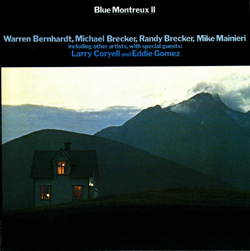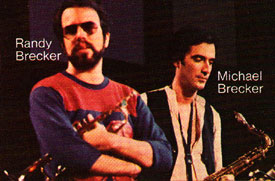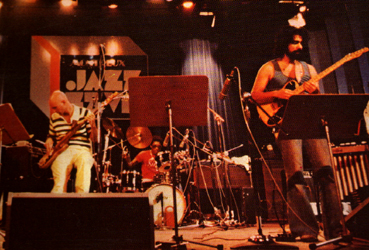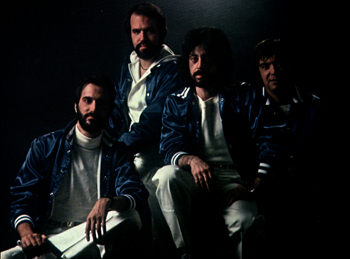Steve Khan's lead sheet:
"Cloud Motion"(Steve Khan)
When Columbia Records assembled the Jazz greats from its All-Star roster to perform and record at the famed Montreux Jazz Festival in 1977, the subsequent recording, "MONTREUX SUMMIT," released in two volumes of double-LPs, set a precedent for the other labels with a Jazz division. In the years that followed, similar festival concerts were recorded and released by Atlantic Records, and also Clive Davis' Arista Records. Even though I was signed to Columbia, I was thrilled to have been asked to play at Montreux again, but this time as part of the Arista All-Stars, with vibraphone great, Mike Mainieri designated to be the leader of the ensemble. This All-Star line-up was to include: Randy Brecker(Trumpet); Michael Brecker(Tenor & Soprano Sax); Warren Bernhardt(Ac. & El. Piano); Tony Levin(El. Bass); Steve Jordan(Drums) and yours truly on guitar. In a sense, I very much felt like part of the "Arista Family" because my acoustic guitar duet LP, "TWO FOR THE ROAD" with Larry Coryell had appeared on Arista, and I was an original member of the Brecker Bros. Band. In an attempt to beef-up the "star power" for the project, we were also told that guitarist Larry Coryell would join us for a couple of tunes. Over the course of several days at the festival, held during July of 1978, we would also be recording an LP with singer/songwriter/pianist, Ben Sidran. And, Mike Mainieri and Warren Bernhardt were going to record an album of duets. The latter was a brilliant recording released on Arista/Novus as "FREE SMILES." In a sense, I very much felt like part of the "Arista Family" because my acoustic guitar duet LP, "TWO FOR THE ROAD" with Larry Coryell had appeared on Arista, and I was an original member of the Brecker Bros. Band. In an attempt to beef-up the "star power" for the project, we were also told that guitarist Larry Coryell would join us for a couple of tunes. Over the course of several days at the festival, held during July of 1978, we would also be recording an LP with singer/songwriter/pianist, Ben Sidran. And, Mike Mainieri and Warren Bernhardt were going to record an album of duets. The latter was a brilliant recording released on Arista/Novus as "FREE SMILES."
Speaking generally, in my experience, when one is asked to participate in any All-Star gathering, it can really be a nightmarish situation. Lots of egos and agendas, managers, etc., and all these elements can conspire to remove the focus from thoughts of the music. In general, for this group, which was not large when compared to the Columbia Jazz All-Stars, we all got along very, very well. Mostly because the friendships involved were already of some duration and the mutual respect factor was very high. Still, for an evening's program of music, shared music, fairness dictates that everyone should be represented in a relatively equal manner. As it turned out, looking back over the two recordings released from the material that was recorded, we played 6 compositions by Mike Mainieri; 2 by Randy Brecker; 1 by Warren Bernhardt; 1 by Michael Brecker; and two by me. We also accommodated Larry Coryell's presence by playing the popular tune by Alphonse Mouzon titled, "A Funky Waltz" which had appeared on the original Eleventh House LP. As you can see, things did not exactly end-up totally equal amongst those who were actually signed to Arista or Arista/Novus. I had suggested this tune because it was simple to learn. It would make Larry feel comfortable and would be easy for us all to mesh together. It is also worth noting that Randy had recorded the original version with Larry.
Recently, a fan sent me an armful of CD covers to sign for him. Amongst those covers was "BLUE MONTREUX II" and this served to remind me of my two tunes which appeared on that recording: "Cloud Motion" and "Candles." The latter I had already recorded with Steve Marcus in 1976, and would record again in 1979 on my "ARROWS" LP for Columbia. The song "Cloud Motion" actually goes back to my earliest years in New York, 1970-72. During that time, I had a band which was called "Future Shock" and featured both Randy & Michael Brecker alongside Steve Robbins(Keys); John Miller(Ac. & El. Bass); and Bruce Ditmas(Drums). We did record a demo together which I haven't unearthed from the closet in ages. Anyway, seeing that CD cover inspired me to finally go to Amazon.com and purchase the CD version. In truth, I was actually more motivated to buy it because it contained Michael Brecker's brilliant Bb blues, titled "Uptown Ed." This track alone makes the CD worth owning! I should also mention that on this jazz blues, it was decided that acoustic bass would make it sound and feel better. And so, the great Eddie Gomez was brought in to overdub the acoustic bass you now hear. This is certainly not an uncommon practice. But, as we are now some 30 years after the fact, I hardly think that it's harmful to confess how this all came about. Just for the sake of historical clarity, our performances were recorded on July 21-22, 1978. And to put this in perspective with my own recordings, "THE BLUE MAN" had been recorded between May 29th and June 2nd of that same year! During that time, I had a band which was called "Future Shock" and featured both Randy & Michael Brecker alongside Steve Robbins(Keys); John Miller(Ac. & El. Bass); and Bruce Ditmas(Drums). We did record a demo together which I haven't unearthed from the closet in ages. Anyway, seeing that CD cover inspired me to finally go to Amazon.com and purchase the CD version. In truth, I was actually more motivated to buy it because it contained Michael Brecker's brilliant Bb blues, titled "Uptown Ed." This track alone makes the CD worth owning! I should also mention that on this jazz blues, it was decided that acoustic bass would make it sound and feel better. And so, the great Eddie Gomez was brought in to overdub the acoustic bass you now hear. This is certainly not an uncommon practice. But, as we are now some 30 years after the fact, I hardly think that it's harmful to confess how this all came about. Just for the sake of historical clarity, our performances were recorded on July 21-22, 1978. And to put this in perspective with my own recordings, "THE BLUE MAN" had been recorded between May 29th and June 2nd of that same year!
Anyway, back to the topic at hand. When the CD arrived I really wasn't certain just which tracks I was going to find, and so, I was happy to see "Cloud Motion" there. And, after loading-in those tunes to my iTunes library, I gave my earliest New York composition a listen. And, miracle of miracles, it actually didn't sound too bad. So, that is why I have decided to share it here. I actually had to re-write the lead sheet because I could not find any of my originals in the closet that houses most of the lead sheets to all my recorded music. It forced me to listen to just how Randy and Michael Brecker chose to interpret the melody I had written. Upon listening, it seems that the written unison passages are played an octave apart. The passages where harmony is present were part of the arrangement, but I think that Michael adjusted the register on the tenor sax to make everything sound better. And then, of course, there is that very particular phrasing style that makes anything performed by these two unique brothers so very special and far better than the way anyone could have written it. Pay special attention to their internal dynamics and the way they interpret each phrasing as one, yet each maintains his individual voice. If you have the actual CD, and choose to listen to the way the melody is played at the top and at the end, you will hear that Randy and Mike do improvise their interpretation of the phrases. The last melody statement is much looser than the way it is played during the initial time through. The art of improvising while playing a melody was something that Randy, Mike and Barry Rogers developed to a high level during their years as part of the group, Dreams. I had chosen this tune for the group because it is, at its core, very simple. There is a basic head and that form remains the same for the solos. There are no interludes based on melodic material which appear between any of the solos. In that sense, the tune harkens back to the Jazz compositions from the mid to late '60s. The pieces which appear on these live Montreux recordings were much more complex, compositionally speaking, and probably far more "Fusion" oriented. This aspect created a lot more work for the group because executing complex pieces with less than adequate rehearsal is most difficult. It is also dependent on the dedication of the players to look over the music between rehearsals and the concerts.
I suppose it is not a coincidence that even back as far as the early '70s, the Afro-Latin influence in my writing was present. The rhythmic underpinning of "Cloud Motion" though written in 4/4 really has a 12/8 or 6/8 Afro-Latin-Jazz feel to it which is beautifully played by Steve Jordan over Tony Levin's triplet-oriented bass part. You should notice that the melodic phrasing is almost always in variations of triplet figures. I am fairly certain that this tune was written at my trusty old Fender Rhodes suitcase model, and I probably sang the melody to myself before committing to it and writing it out. I can't be totally certain, from a compositional standpoint which older Jazz tunes might have served as an influence or a 'model' for this format. By that I mean that the piece has 28-bar form and that is divided into 7 4-bar phrases, each over a single chordal/harmonic area. Off the top of my head, I think about tunes like Herbie Hancock's "Maiden Voyage" or Donald Byrd's "Fancy Free." I only mention these tunes because of the extended amount of time one gets over each chord. By Jazz standards, pre-'70s, 4 bars is a rather long time on one chord. After now, having heard "Cloud Motion" after so many years, it feels like a very organic piece. Its movement is a bit like a circle, in that you begin with 4 bars of D7(9sus) to 4 bars of Fmaj7(9#4) and then, you end with the reverse movement. That is to say, for the last 8 bars of the tune, you have 4 bars of Fmaj7(9#4) followed by 4 bars of D7(9sus), which is where the piece concludes. As such, when the solo format loops around, the player gets to play over 8 bars, in total, of the D7(9sus) sonority which is nice, and feels very natural. As it turned out, I guess that we decided that, for this tune, the soloists would be Randy, myself, and then Mike Mainieri. As this was still during the LP era, one really had to consider that having tunes with double-digit timings would be most counter-productive. As it is, the tune ended-up being 9:32, which, all things taken into account, is pretty long! I can't be totally certain, from a compositional standpoint which older Jazz tunes might have served as an influence or a 'model' for this format. By that I mean that the piece has 28-bar form and that is divided into 7 4-bar phrases, each over a single chordal/harmonic area. Off the top of my head, I think about tunes like Herbie Hancock's "Maiden Voyage" or Donald Byrd's "Fancy Free." I only mention these tunes because of the extended amount of time one gets over each chord. By Jazz standards, pre-'70s, 4 bars is a rather long time on one chord. After now, having heard "Cloud Motion" after so many years, it feels like a very organic piece. Its movement is a bit like a circle, in that you begin with 4 bars of D7(9sus) to 4 bars of Fmaj7(9#4) and then, you end with the reverse movement. That is to say, for the last 8 bars of the tune, you have 4 bars of Fmaj7(9#4) followed by 4 bars of D7(9sus), which is where the piece concludes. As such, when the solo format loops around, the player gets to play over 8 bars, in total, of the D7(9sus) sonority which is nice, and feels very natural. As it turned out, I guess that we decided that, for this tune, the soloists would be Randy, myself, and then Mike Mainieri. As this was still during the LP era, one really had to consider that having tunes with double-digit timings would be most counter-productive. As it is, the tune ended-up being 9:32, which, all things taken into account, is pretty long!
For the purpose of this newly rewritten lead sheet, I decided to include some letters to mark the sections, even though I don't think that having more than an [I] for the Intro, and just an [A] for the body of the tune is really necessary. Sometimes, for rehearsal purposes, it is easier to just call out a letter rather than a specific bar number. So, with that in mind, I chose to label the passage beginning with the Am7(9) chord as letter [B]. The last 4 bars of the tune become [A2] as it does, in essence, mirror the first 4 bars. For me, now that I have heard this tune again, and for the first time in many, many years, I was struck by the wonderful dynamic shift that we made at [B] when that Am7(9) chord arrives. The volume drops way down and, to these ears, the piece takes on a sense of greater romanticism. I can't be certain, but I have a feeling that I originally felt that the entire tune was just one long crescendo. So, it now becomes obvious to me that the seasoned instincts of all the other great players was that we should drop down in level. There is no question that they were completely correct! It serves now as a great lesson in learning to listen to your bandmates because sometimes their instincts are far better than yours. Perhaps because they are much less emotionally invested in the tune?
I would like to share a couple of anecdotes surrounding this recording, which I am hoping will serve as some form of a 'music business' lesson for those musicians, young and old, who might be reading these pages. As the idea for what became "BLUE MONTREUX" was being hatched between Steve Backer(Arista) and Mike Mainieri, at a certain point, even before I had been asked to participate, Mike phoned me to 'pick my brains' about how everything had been handled with the CBS Jazz All-Stars performance and subsequent LP releases for "MONTREUX SUMMIT." And so, as I have such great respect for Mike, and we were becoming truly good friends then, I shared with him any and all information that I thought would be useful to him and the other players as well. On a business level, I told him that it was my impression, based upon how Vol. I and Vol. II had sold, that if I had the power to do so, I would make certain to get as many of my own tunes on Vol. I as was fair and possible. The reason being that Vol. I of "MONTREUX SUMMIT" had out-sold Vol. II by well over three times as many!!! Little did I know that, some time down the road, this information would be used in a way that was hurtful to me!!! On Vol. I of "BLUE MONTREUX" Mike Mainieri ended-up with 5 of his compositions presented. There were NONE of mine on that edition. Both of my tunes appear on Vol. II. At the time, I didn't think it was too funny, especially because there is never a guarantee that there will ever even BE a Vol. II. So, I guess I'm saying here that, you should weigh and measure the sage advice you dispense before sharing everything you might know with anyone!!!
My other story involves the rather petty nonsense that often exists between record companies and their executives. As music business historians would note, it was common knowledge that Clive Davis was let go by Columbia Records after he had brought the company to great prominence, and he was quite bitter about this. So, when he began his own label, Arista Records, there was, without question, a competitive feeling between his label and Columbia which was then under the helm of Bruce Lundvall. Bruce, in my view, has always been a great gentleman. During my years as a member of the Brecker Bros. Band, I never had the greatest feeling about Clive Davis and it was my feeling that he did his part to undermine the band relationships and the chemistry that we had all built together. There is a famous story from a meeting that was held between Clive, Randy & Mike, and their manager at the time. The quote from Clive Davis is something which I just can't, in all conscience, repeat here. So, don't write and ask me about it! Anyway, though the "BLUE MONTREUX" recordings are rarely discussed, when someone does bring it up to me, I am often asked: "Steve, why is your name not included on the cover?" Well, there is quite a story behind that.
I have mentioned the rancor that existed between Arista and Columbia, and between Clive Davis and Bruce Lundvall. You have to remember that I was signed, as an artist, to Columbia Records even though, as part of my contract I was always free to record with artists from other labels. However, a legal permission had to be granted so that my name, or likeness(a photo), could be used on whatever LP that happened to be. In this case, Arista wanted to put my name on the cover with the rest of the guys. Needless to say, to have been thought of as an 'equal' in this collection of great, great players could have only been seen as a terrific boost to my career, which was really just beginning. In my opinion, having my name on the cover would only draw attention to my Columbia recordings as a leader. How could that possibly have been viewed as a bad thing? But, forget about logic here. Bruce Lundvall refused to give Arista, and Clive Davis, permission to use my name on the cover. And so, it appears that I am nothing more than some kind of very minor sideman, when, in fact, like the other guys, I was very much a co-leader in my own right. This was so frustrating to me, being caught in the middle of this old, old battle, and there was nothing that I could do to change these rather petty decisions. To me, it was terribly hurtful that my name was never allowed to appear on the cover. Sometimes, even very sage and savvy record executives can make a decision which really is absolutely not the best thing for the career of one of their artists. I have to admit that this still eats away at me, though in truth, I rarely think of it. Yet, it only takes the slightest reminder, and I can go right back to that time and place in a heartbeat!
As a small postscript to the story, I was recently signing some CD covers for a fan, and I saw the RCA/Bluebird release of "BLUE MONTREUX." This CD offers 8 of the tracks 12 tracks we recorded and, miracle of miracles, my name was included on the cover this time. Strangely, Eddie Gomez was omitted, not to mention Tony Levin and Steve Jordan. However, I am certain that my name was included because Michael Cuscuna was the "Reissue Producer." He and I have remained friendly for many, many years. So, it's a little too late to make a difference, but I am grateful to him, nonetheless!!! A happy ending to another story!
[Photos of Randy & Michael Brecker; and Tony Levin, Steve Jordan, & Steve Khan
by John Ford, Montreux, Switzerland, 1978.
Photo of Michael Brecker-Randy Brecker-Mike Mainieri-Warren Bernhardt by Robert Dibue]
|

